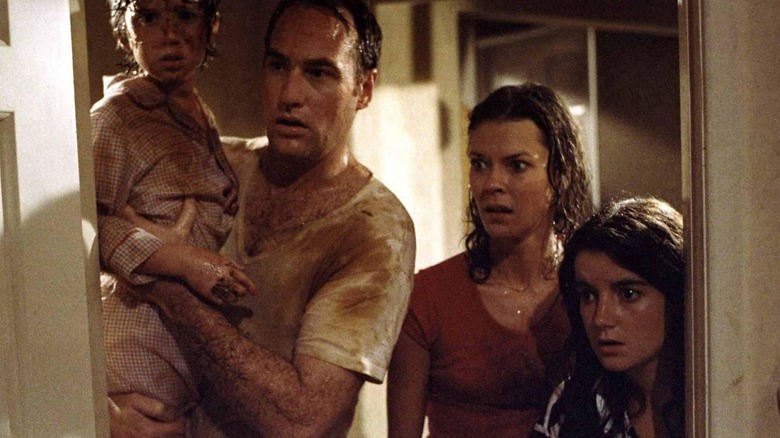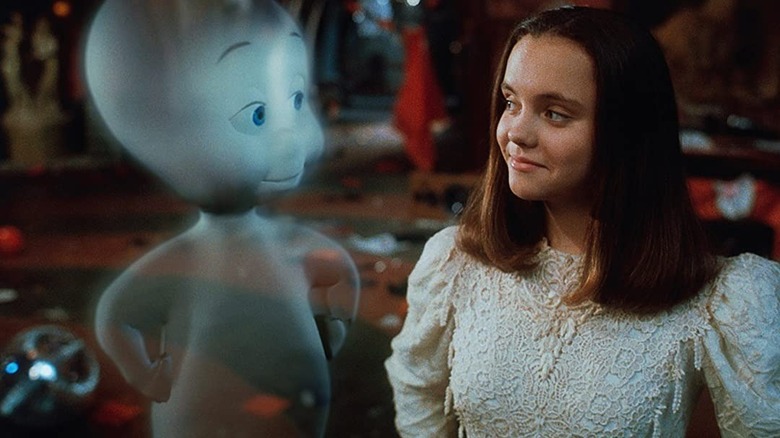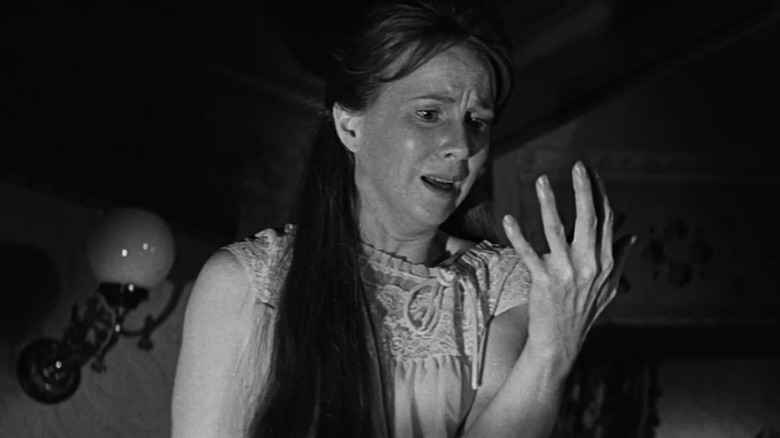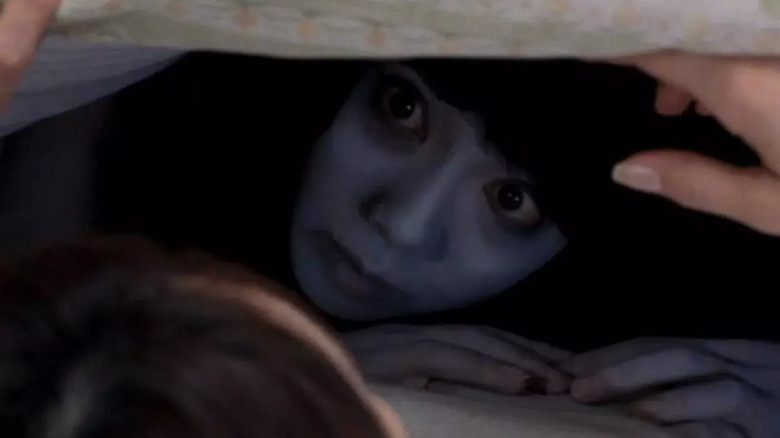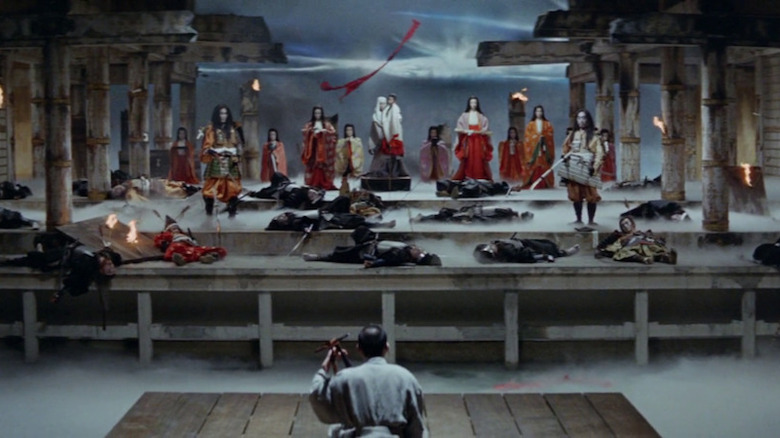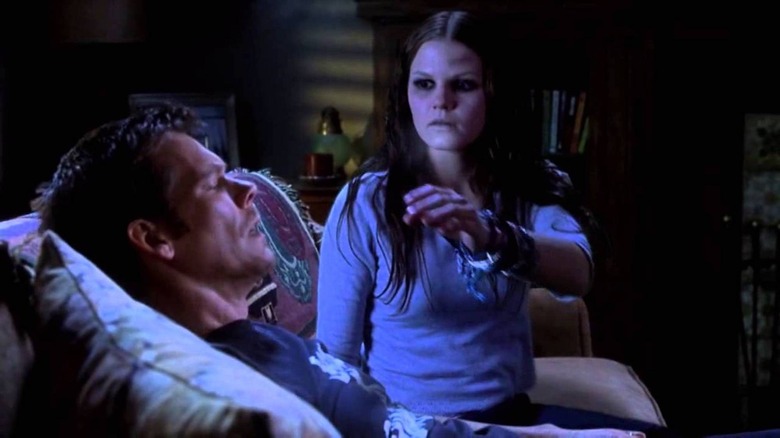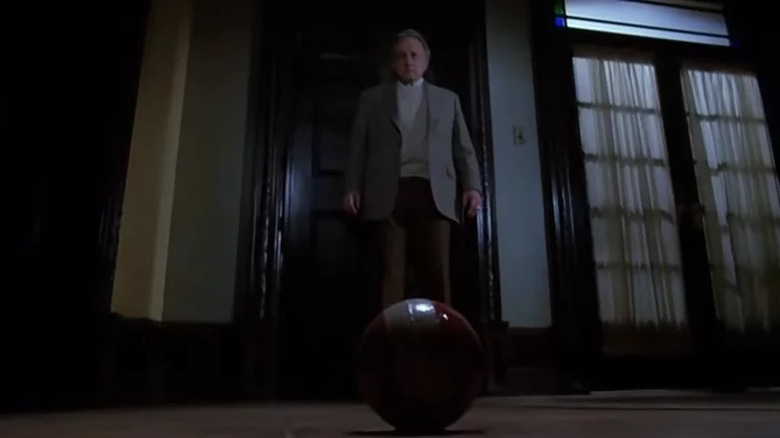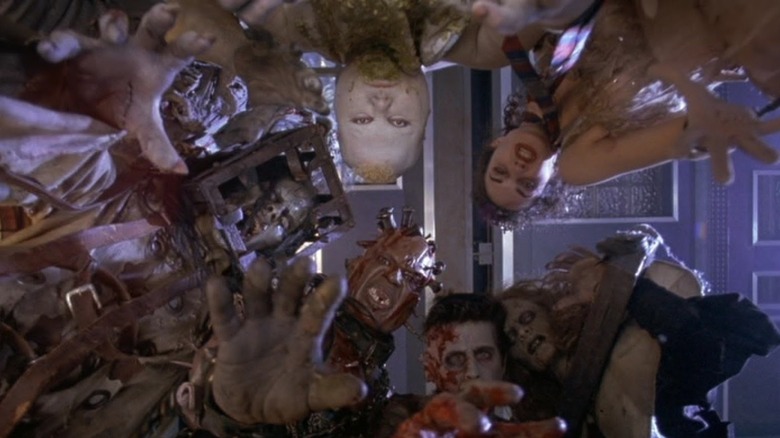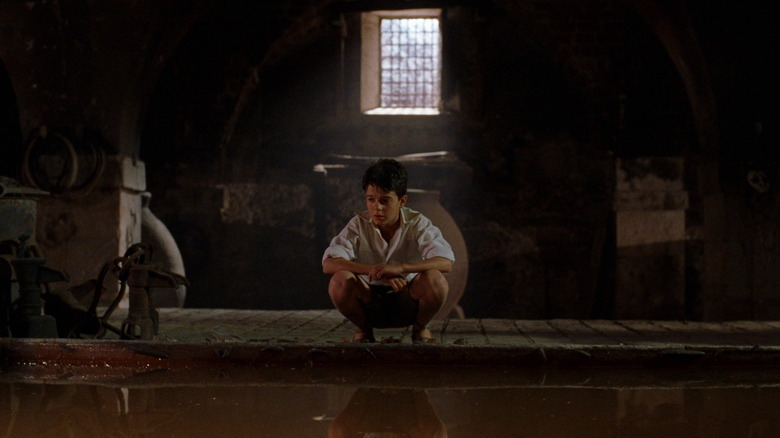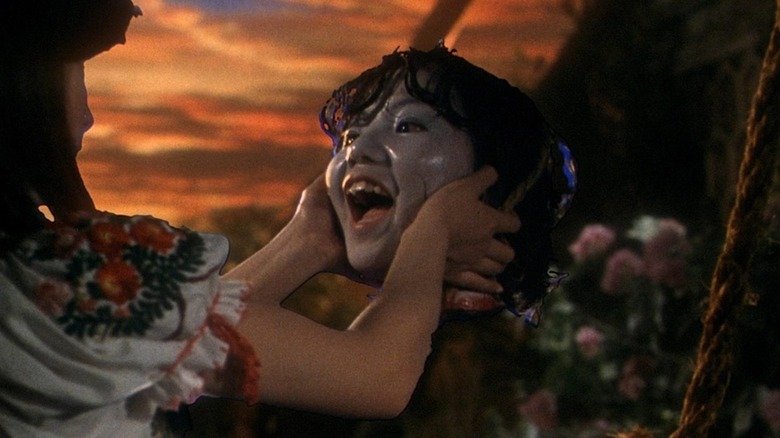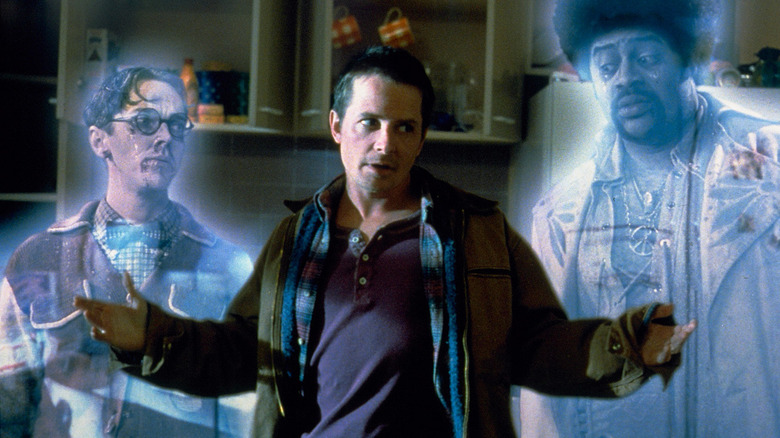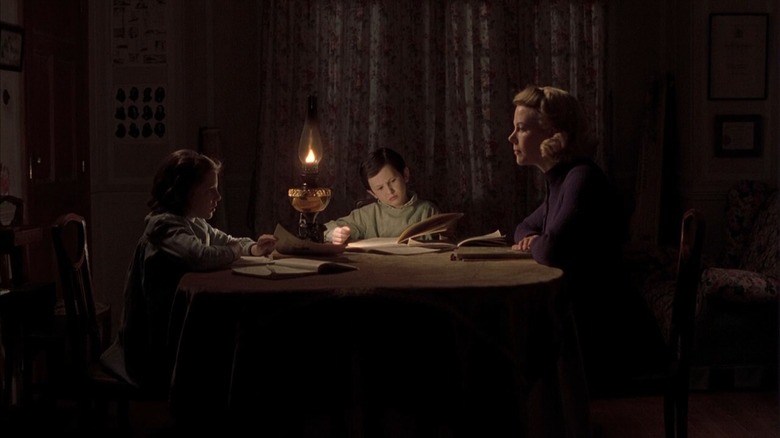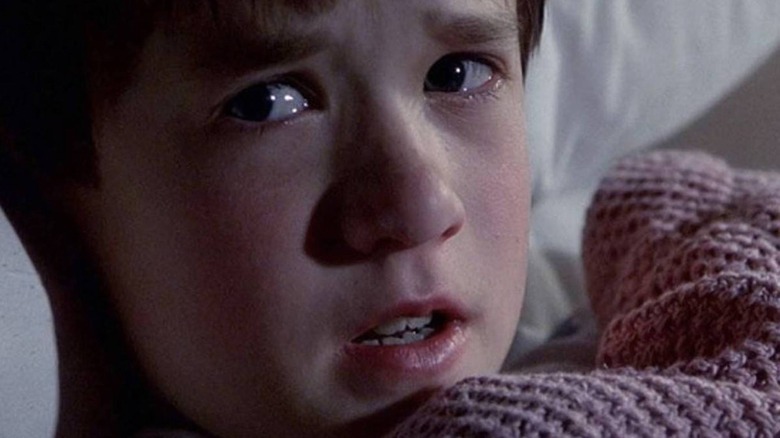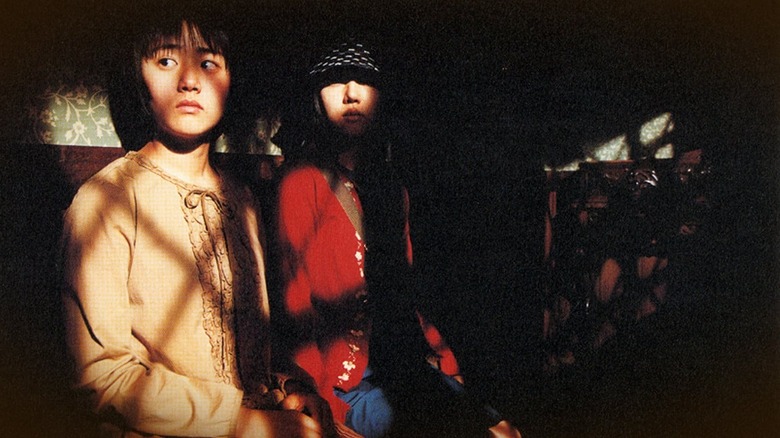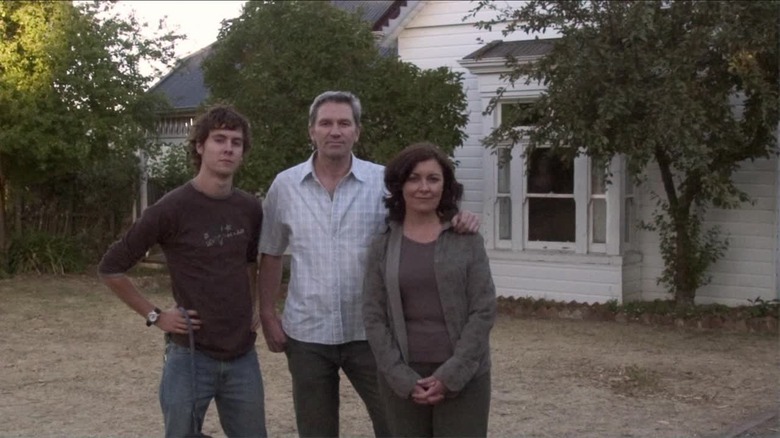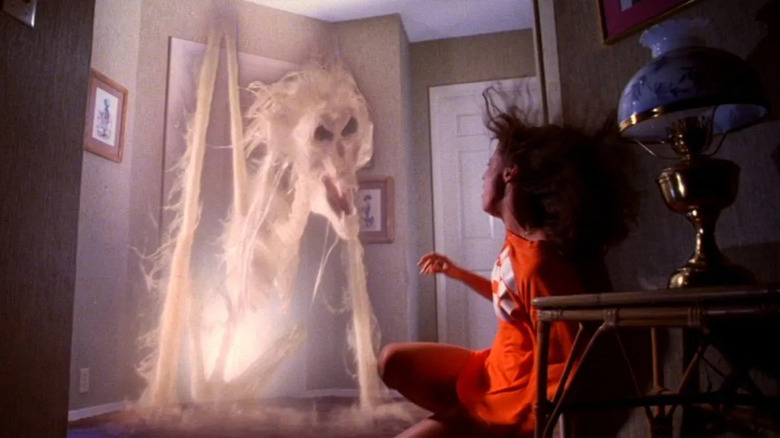The 15 Best Ghost Movies Of All Time, Ranked
Specters and poltergeists and ghosts, oh my!
Haunted houses litter the horror landscape, but some are eerier than others. From family-friendly features to truly terrifying tales, ghost stories can span a wide range of themes and play out in a million different ways to varying degrees of success. So what makes a ghost story truly great? And what are some of the best ghost movies of all time? Well, you've come to the right place! The /Film team put their heads together and came up with a huge list of potential titles, only to whittle them down to the top 15 movies on this list. From classics like "The Changeling" to potentially unexpected gems like "Casper" (yes, the one starring Christina Ricci and Devon Sawa as the ghost's human form), your bases are well covered here.
So turn out the lights, grab some popcorn, and listen closely as we tell you about these essential spectral stories you have to watch.
15. Casper
Perhaps one of the best transitional horror movies ever made, the family flick "Casper," is an all-time ghostly great.
Based on the popular Harvey comics series "Casper the Friendly Ghost," the 1995 supernatural, dark fantasy dramedy has a lot more going for it than most remember. Often remembered as a silly children's movie about a CGI ghost kid looking for a friend, "Casper" is a surprisingly powerful examination of neglect, grief, and our inability to process the finality of death. Paranormal therapist James Harvey (Bill Pullman) moves into the haunted Whipstaff manor with his daughter Kat (Christina Ricci), desperately trying to contact the spirit of his deceased wife. After initially being scared of the ghosts inhabiting the manor, Kat befriends Casper (voiced by Malachi Pearson), the son of an inventor who eventually drove himself into madness trying to bring him back from the dead.
There's a sinking sadness to "Casper" that is effortlessly offset by its moments of joy, allowing the problems in the Harvey family's life to hold equal weight to the desires of Casper and his trio of ghostly uncles also residing in the home. Death is not treated as a taboo subject too difficult for young viewers to understand but is also presented in a way that emphasizes the severity of pain that can occur after losing a loved one. Mourning is difficult and people process death in a variety of different ways, and few movies showcase this truth quite like this one. "Casper" is equal parts fun as it is frightening, making it an incredible way to introduce the themes of mortality to audiences of all ages. (BJ Colangelo)
14. The Haunting
Long before Mike Flanagan terrified audiences with "The Haunting of Hill House," there was Robert Wise's 1963 adaptation of Shirley Jackson's novel, "The Haunting."
Robert Wise is truly one of the greatest directors to ever put moving pictures to celluloid, and "The Haunting" is an absolute masterclass in tension. Wise perfected the modern Gothic drama and did so without needing to rely on graphic, revolting imagery, or jarring editing techniques. Rather, Wise utilized the set design, cinematographic framing, lighting, split diopters, and an effective sound design to keep his audience keyed up. When we think of the expression "less is more," few films encapsulate the practice quite like this film.
There's something in this house, but the audience is never given the chance to see just what that something is. The power of "The Haunting" is its constant sense of creeping dread, and while the atmosphere is eerily restrained, it works in perfect juxtaposition against Julie Harris' performance as Eleanor. Harris delivers one of the all-time great horror movie performances as a woman constantly on edge, with a palpable sense of anxiety and genuine fear. When the frightening moments strike, it is Harris who helps raise the stakes, as her reactions are oftentimes more horrific than the actual hauntings.
Martin Scorsese has gone on record to declare "The Haunting" as the scariest horror movie he's ever seen, and it's hard to argue his point. "The Haunting" is a phenomenal work of art and without the film's success, the subgenre of ghost movies may not have been possible. (BJ Colangelo)
13. Ju-On: The Grudge
There was a huge boom in Japanese horror films around the turn of the 20th century as filmmakers like Takashi Miike and Hideo Nakata unleashed their terrifying tales on unsuspecting audiences. Many of these films were remade in America, including the 2002 classic "Ju-On: The Grudge," though they rarely held a candle to the originals. "Ju-On," written and directed by Takashi Shimizu, is a deeply disturbing ghost story that transcends cultures and never really needed a remake, even if Shimizu himself directed it.
"Ju-On" is technically the third movie in the franchise, though it's the first one to get a theatrical release. The first two films, "Ju-On: The Curse," and "Ju-On: The Curse 2," were only released on television in Japan, and thus "Ju-On: The Grudge" was the first part of the franchise to make it overseas. The movie follows a young woman named Rika, played by Megumi Okina, who works as a social worker and caretaker for the elderly. While she takes care of an old woman, she discovers a curse in the house and its not-so-friendly ghost inhabitants.
A big part of the success of "Ju-On" was just how creepy its two ghosts managed to be. The young boy ghost, Toshio, and his murdered mother Kayako are two of the scariest spirits in horror history, and Kayako's unnerving staircase walk is unforgettable. "Ju-On" is a distinctly Japanese story that manages universal appeal, using traditional imagery and themes to tell a terrifying story anyone can relate to. While many ghost movies hesitate to reveal their creepiest cast members, "Ju-On: The Grudge" utilizes them to perfection. (Danielle Ryan)
12. Kwaidan
It's about time that a horror anthology made the list. "Kwaidan" is a 1964 four-part feature pulled from Lafcadio Hearn's retold collection of Japanese ghost tales. The segments, each rooted in a morality lesson, run from mournful to "Twilight Zone"-levels of surreal. The strongest segment in the assembly is "Hoichi the Earless," a sweeping story shot on elaborate theatrical sets showcasing this mythic, larger-than-life feel. In it, a young musician is summoned from his temple to perform an epic poem for a dead emperor and his court. Hoichi can't see the phantoms, but the viewer can, and the saga is delivered with plenty of time for ornate displays of life and death, at a three-hour runtime. The U.S. premiere saw the movie's wings clipped a little bit more, lopping off the entirety of the segment "The Woman of the Snow."
Potential spoiler: the plottings of the story's lady monster resemble those of the morbid "Lover's Vow" segment from John Harrison's 1980 anthology "Tales From the Darkside," culled from the same Hearn collection, "Kwaidan: Stories and Studies of Strange Things."
Don't come for scares, even though there are some unnerving parts; come for the polish on it. The sight of the samurai clan battle from the poem isn't going to be as violent as a horror fan might expect, and the film holds back from gruesomeness. In "Kwaidan," ghosts are accepted as real and part of everyday life instead of something to be debunked. They're both eerie and gorgeous, unnerving and magnetic. Every story swings like this, back and forth between the dead and the living, and the balance keeps going with a soundtrack from composer Toru Takemitsu, who gave an equally ambitious score to Akira Kurosawa's "Ran." The result is so immersive that walking away after the end of Kobayashi's "Kwaidan" feels like barely escaping with one's life, and living to tell the tale. (Anya Stanley)
11. Stir of Echoes
There were two great ghost movies in 1999, and one of them was David Koepp's "Stir of Echoes." It's an adaptation of Richard Matheson's 1958 novel about an average working-class guy named Tom who has a kind of second sight awakened within him, and how that sends his life into a tailspin.
The film stars Kevin Bacon as a cynic who gains the ability to communicate with the dead after being hypnotized. He goes from not believing in ghosts to seeing one in an instant. Not only can he see this off-putting apparition, but he can also see the circumstances of her death. As he begins to piece together exactly what happened to her, he gets closer and closer to a revelation that will not only put him and his family in danger but could very well tear his seemingly happy little neighborhood apart.
While it was a moderate hit, "Stir of Echoes" got drowned out by the monster success of "The Sixth Sense" which hit screens just one month prior to its release. This was a huge shame because Koepp's movie is skillfully made all around. The acting is top tier, the mystery is compelling, the scary stuff is legitimately disturbing, and it's all told in a tight one-hour and 39-minute story.
"Stir of Echoes" and "The Sixth Sense" complement each other really nicely: they're both tales about how ghosts aren't nearly as scary as the living and both have cute little kids that can speak with dead people.
While "Stir of Echoes" might never have the same impact on pop culture as its spooky 1999 twin, expect it to have a longer than average shelf life for a genre film. (Eric Vespe)
10. The Changeling
Horror cinema owes a great debt of gratitude to Peter Medak's "The Changeling." The truly iconic ghost story starring George C. Scott influenced some of cinema's greatest filmmakers including Martin Scorsese and Guillermo del Toro. "The Changeling" is the reason we have much of the "Conjuring" universe, moments from the "Insidious" franchise, and seems to have been a big influence on "The Ring." Not to mention the film's influence on "Poltergeist" and the fact that "The Others" literally would not exist without it.
After losing his wife and daughter in a tragic car accident, John Russell (Scott) moves from Manhattan to Seattle for a position teaching music composition at the local college. He rents an old Victorian mansion, the perfect place for him to live and work, except it seems he's not alone. A presence resides within its weary walls, the spirit of a little boy who was murdered by his father and replaced with a changeling. He wants something, but what is unclear, and only John can help.
Like some of the best titles on this list, "The Changeling" masters the elements of a memorable ghost story: humanity, grief, and loss. The film is a poignant meditation on the way we process grief and how that pain is part of the healing process. It weaponizes happy memories, turning keepsakes into nightmare fuel with the power to destroy you.
"The Changeling" is timeless, a haunting story about loss and grief that resonates with everyone, regardless of age. The older you get, the more horrifying and heartbreaking it becomes. It truly gets better with age. (Ariel Fisher)
9. Thirteen Ghosts
Following in the footsteps of the Dark Castle Remake of "The House on Haunted Hill," the adventurous "Thirteen Ghosts" (or "Thir13en Ghosts" according to the marketing) took Y2K-era horror sensibilities and combined them with a terrifying rogues' gallery of brilliant ghost characterizations.
Steve Beck's "Thirteen Ghosts" gave the William Castle story much-needed defibrillation, exchanging the funhouse aesthetic of slamming doors and throwing dishes for extreme violence and graphic deaths. The original film centered on an occultist who captured ghosts from around the world, and for the most part, "Thirteen Ghosts" follows a similar premise. However, it's the inclusion of the ghosts as part of the Black Zodiac that has given the film its staying power after all these years. Characters like The Angry Princess, The Juggernaut, and The Jackal became nightmare fuel for a generation, and continue to terrify audiences even today.
At the turn of the millennium, filmmakers were fascinated with the advances in technology and often incorporated these elements into their work. The house of the "Thirteen Ghosts" remake trades in the classic residential home of yesteryear for a high-tech glass home with inscriptions embossed on the walls. The new setting immediately adds an increased level of anxiety for the viewer, with the sliding, mechanical doors providing the constant threat that the inhabitants are never safe. At any moment, a malfunction could occur, unleashing the vengeful spirits to enact a reign of terror.
Horror from the aughts is often dismissed as a sea of slasher remakes in the wake of "Scream," but the 2000s delivered plenty of quality films, and "Thirteen Ghosts" is one of them. (BJ Colangelo)
8. The Devil's Backbone
There's plenty of Gothic horror to be found on any list of the best ghost stories, but "The Devil's Backbone" stands head and shoulders above most. The Spanish-Mexican effort follows in the Guillermo del Toro spirit his work is known for, of allegory infused with the supernatural.
Set in 1939 in the midst of the Spanish Civil War, a young orphaned boy named Carlos (Fernando Tielve) struggles to fit in at a remote orphanage, where he's subjected to bullying and crime, and that's before the specter of a dead boy shows up. Instead of a haunted castle in this ghost story, the orphanage is the isolated setting — and it is isolated, even tomb-like. The danger becomes even more insistent with an unexploded bomb sitting in the courtyard, just another consequence of war for these kids.
Like many of his other films, some adults are safer than others, and certain humans are bigger threats than the spirits. While the ghost haunting the orphanage is good for creepy moments, the film is more obsessed with conceptual and generational specters, and the way that war irritates and complicates the healing process for everyone. "The Devil's Backbone" is anchored by a luminous cast that includes prolific Argentine actor and three-time del Toro collaborator Federico Luppi, also seen in "Cronos." Richly textured in warm sepia and icy blues and deliberately paced to give as much life to its characters as possible, "The Devil's Backbone" is both warm and icy, tender and distraught. (Anya Stanley)
7. Hausu
Ghost movies are typically associated with the familiar, dreary aesthetic of dusty old houses and spirits donning antique garb, but 1977's "Hausu" couldn't be more different. Known to English-speaking viewers as "House," Nobuhiko Obayashi's paranormal psychedelic masterpiece is an assaulting visual buffet of disembodied heads ready to bite a victim in the rear, random bursts of animation, a piano that chomps people into little pieces, dancing skeleton puppets, and a painting of cat with the ability to spit enough blood to drown an entire house.
After a young woman named "Gorgeous" invites her friends to her aunt's countryside manor, the group is terrorized by the colorful and outlandish haunts that await them. Obayashi wrote the film with influences from his young daughter, Chigumi Obayashi, not unlike how Robert Rodriguez wrote "The Adventures of Sharkboy and Lavagirl." The result was a disturbingly imaginative ghost story that leaned into frenetic and camp aesthetics, reveled in less-than-stellar special effects, and threw audiences into a fever dream that only a small child could have concocted. The bizarre presentation feels like a precursor to horror greats like Sam Raimi and Peter Jackson, playfully incorporating absurdist humor against the backdrop of graphic horror.
Ghost movies don't often get the chance to have fun, but "Hausu" is as hilarious as it is effectively creepy. Despite the constant barrage of disturbing (albeit silly) imagery, there's something whimsical about "Hausu" that entices audiences and makes it difficult to look away. "Hausu" continues to be hailed as one of the best Japanese horror films ever made, and truly showcases the potential of ghost movies if creatives are willing to take a wild swing. (BJ Colangelo)
6. The Frighteners
Before he made "The Lord of the Rings," director Peter Jackson made a handful of horror movies, including the horrifying and hilarious "The Frighteners" in 1996.
"The Frighteners" stars Michael J. Fox as Frank Bannister, an architect whose wife dies in a tragic accident that also leaves him with the ability to see and talk to ghosts. Instead of dealing with his trauma and grief and continuing his life, Frank becomes a con man, befriending a trio of ghosts played by Jim Fyfe, Chi McBride, and John Astin. The ghosts help him haunt the town, and he charges unsuspecting homeowners to "exorcise" the spirits. The real problem starts when a demon starts haunting the town for real, and Frank is the only one who could possibly stop him.
"The Frighteners" is a horror-comedy that leans harder into being funny than scary, but Jackson's ability to frighten is still on full display. It's rated R for violence and terror and isn't the kind of fluffy, family-friendly fare you'd expect from his later films or Fox's usual oeuvre. Fox also plays against type a bit, portraying a character that's likable enough but does a lot of scummy things. He's a far cry from Marty McFly, but he's still hilarious and charming in a much more adult way.
What's so fascinating about "The Frighteners" is that it manages to balance gross-out humor and intense violence with a warm, gooey center that's as much marshmallow fluff as it is blood and guts. This is a unique horror-comedy directed by one of the genre's best, and its ghostly characters are some of the most "fleshed out" in all of cinema. (Danielle Ryan)
5. The Others
Alejandro Amenábar's 2001 thriller "The Others" is impressively frightening given its simplicity. This Hitchcockian tale follows a woman named Grace, played perfectly by Nicole Kidman, who lives with her two children in a mansion in Bailiwick of Jersey while she waits for her husband to return from World War II. The children are photosensitive, meaning that they cannot be in direct sunlight or it will hurt them, and so Grace enacts strict rules to allegedly keep them safe. When she hires a group of servants to help her care for the house and her children, the carefully crafted environment begins to crumble, and the family's true horrors are revealed.
"The Others" is an unconventional ghost story with all of the usual set pieces: creepy kids, a sprawling mansion, and mildly terrified visitors. It's a slow burn that builds gradual dread instead of relying on jump scares or scary imagery, playing a psychological game with both its characters and the viewer. Kidman's performance is the glue that holds everything together, giving it her all and delivering a complex character. Having children is like having a piece of your heart outside of your body, and having children with such debilitating conditions must be absolutely terrifying. As much as audiences fear the ghosts the children talk about, they also fear for the children's safety from the outside world and the thing that usually helps humans thrive: the sun.
With "The Others," the less you know, the better. It's a smartly subversive thriller that flips some tropes on their heads while leaning into others, held together by excellent performances and even better cinematography. It's also not terribly violent, so this PG-13 horror can be shared with some younger viewers. (Danielle Ryan)
4. The Sixth Sense
"The Sixth Sense" is not only one of the best genre movies ever made, but it is also one of the highest-grossing ghost stories of all time, coming in at $672.8 million in box office receipts. The "Pirates of the Caribbean" movies and "Coco" rank higher on the all-time box office and are obviously ghost stories, but not ones focused on frights. In fact, the only flat-out horror movie that has outgrossed "The Sixth Sense" is 2017's "It."
"The Sixth Sense" was such a cultural phenomenon that it has been the go-to example of a twist ending for over 20 years. The reason the movie has lived on in the hearts and minds of film fans the world over, however, is that the twist is only the cherry on top. The real staying power of "The Sixth Sense" is on the shoulders of writer/director M. Night Shyamalan and stars Haley Joel Osment, Bruce Willis, and Toni Collette.
This story of a little boy cursed with the ability to see dead people and the lost psychiatrist who sees him as a way to make up for failing a previous patient is immaculately written, performed, and shot. Shyamalan takes his time, really setting the stage to get to know and love these characters before we start seeing the horrific images this poor kid is faced with on a daily basis.
Yes, the twist is all-timer stuff. It's perfectly set up and the revelation is a gut punch on an emotional level, but the story isn't about the trick and that's why people still hold it up as one of the best genre movies in recent memory. (Eric Vespe)
3. A Tale of Two Sisters
Since so many ghost stories blur the boundaries between the internal and the external, many of the best ones are devastating tiptoes toward the edge of someone's unstable psyche. "A Tale of Two Sisters" is one such masterpiece where the hauntings are coming from inside the house on a psychological level as well as a physical one.
Kim Jee-woon's modern folktale is adapted from a classic one — in which two young sisters are killed by their vicious stepmother — hailing from Korea's Joseon Dynasty and getting about as many adaptations as Charles Perrault's "Bluebeard" tale. The story follows a young woman, eldest daughter Su–mi (Im Soo-jung), fresh out of a mental institution. Su-mi struggles with herself and the cryptic question asked at the beginning, "Who do you think you are?" She goes back to her confined childhood home along with her sister where disquieting events unfold that seem tied to their judgmental stepmother, Eun–joo (Yum Jung-ah), and a grim, mysterious family past, while Su-Mi's distant father, Moo–hyeon (Kim Kap-soo), hints that something is off about the family dynamic.
It unravels alongside Lee Byung-woo's masterful score; the epilogue music conjures up a swell of emotions as conflicted as its story. But the conflict is on purpose, because "A Tale of Two Sisters" is a ghost story about perspective, and about the triage of reality that deploys in people's memories. The movie hits hard not with ghostly moans, but with the heartfelt wails and dread-filled silence of a Shakespearean tragedy where the human mind rebels more than a creaky house, and everyone is punished for their past decisions, with hellish consequences. (Anya Stanley)
2. Lake Mungo
Joel Anderson's devastating 2008 Australian psychological horror film "Lake Mungo" came along at a wild time for the found footage subgenre. It was the same year that shaky-cam scares chronicled a kaiju attack in "Cloverfield" and an L.A. apartment under government lockdown in "Quarantine," itself a remake of the 2007 Spanish film "REC." Only the year before, Oren Peli's "Paranormal Activity" screened at Screamfest Horror Film Festival, starting the journey towards Jason Blum and a megahit wide release that made a found-footage movie one of the most profitable horror movies ever. What makes "Lake Mungo” different is its marriage of found footage and mockumentary approaches used to tell what appears to be a ghost story.
The story chronicles a family's search for answers in the wake of sixteen-year-old Alice Palmer's (Talia Zucker) drowning death. When her brother Mathew (Martin Sharpe) captures images that look vaguely like Alice on and around the family's property, the narrative takes several ghastly, soul-crushing turns. Not much more can be said without spoiling the movie, but its scare power lies not in jumps and shocks, but in imagery that lies in plain sight, priming the pump for similar dread-filled revelatory scares in Ari Aster's "Hereditary" and Andy Mitton's "The Witch in the Window." Presented docu-fiction style, the movie hits like something lurid found on tv during the insomniac witching hours. Not only does the footage manipulate, but Anderson includes sly judgment on the viewer who falls for it, all while keeping grief and bereavement due north throughout the story.
"Lake Mungo" is not a movie to put on in the background; for the brave and bold movie watchers unafraid to lean into the screen, this is a lights-out, sound-up kind of experience. (Anya Stanley)
1. Poltergeist
"Poltergeist" scarred a whole generation who will never trust static on TVs or creepy clown dolls as long as they live. It also happened to modernize the ghost story in a whole new way.
Horror in the 1970s and 1980s was all about bringing the monsters of yore into a recognizable world, away from gothic castles and foggy European graveyards. Tobe Hooper did that with "The Texas Chain Saw Massacre," bringing his iconic killer into recognizable small-town Texas, and Steven Spielberg delivered a believable great white shark to the shores of a small coastal town in "Jaws." It was only fitting that the two would team up to completely redefine how audiences saw ghosts on film in "Poltergeist."
Spielberg wrote the script himself, his first screenplay credit since "Close Encounters of the Third Kind," which tells the story of the Freelings who could be the family up the block. Ghosts in suburbia were not a common thing at this point, which makes their appearance here all the more shocking.
"Poltergeist" doesn't pull any punches. Kids are constantly in danger, when the ghosts show up they're far more terrifying than just spectral shapes or people in ratty clothes and white pancake makeup, and all that tension is only heightened because you care about this family. It could be your own! One day you might wake up to find the old backyard tree trying to eat your kid!
With a wonderful Jerry Goldsmith score, beautiful cinematography, fantastic performances, and ILM at their best, "Poltergeist" remains a classic. (Eric Vespe)
